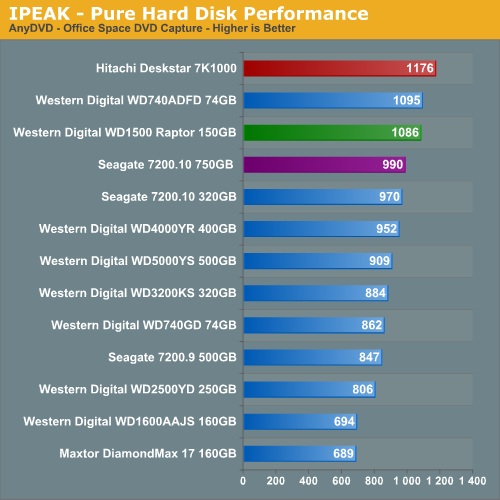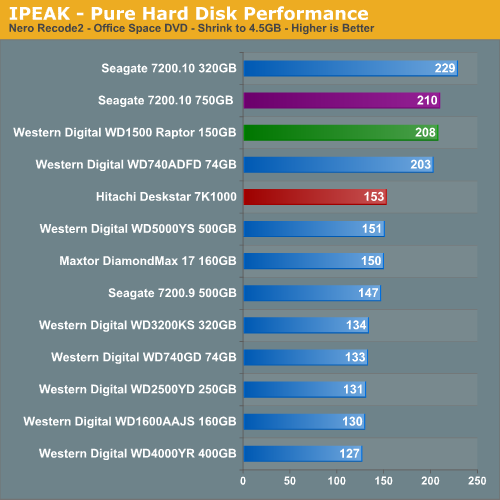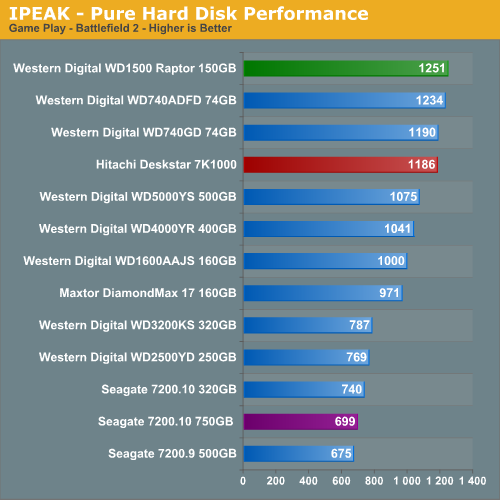Hitachi Deskstar 7K1000: Terabyte Storage arrives on the Desktop
by Gary Key on March 19, 2007 8:00 AM EST- Posted in
- Storage
iPeak Video/Audio Tests
The iPeak based Video/Audio benchmarks are designed around simulating media encoding and HTPC activities. These are basic benchmarks at this time as this section will be expanded once we start testing under Vista. Our change to a dual core processor will assist us in maintaining a balance between the CPU and Storage systems during the trace file creation and benchmarking processes. These benchmarks are CPU intensive in nature but also require a balanced storage system with the ability to handle read and write requests simultaneously in a very efficient manner.


The AnyDVD benchmark is heavily weighted to write requests with the results showing a common pattern with the two 16MB cache Raptors finishing second and third with the 7K1000 once again showing its strength in the write intensive benchmarks due to its areal density and large cache design. We found the Seagate 750GB was pausing during streamed writes due to the smaller cache size after witnessing buffer overruns in the trace file when compared to the Hitachi drive.
The NeroRecode 2 benchmark is weighted to streaming read requests but is balanced by continuous write operations near the end of the test. This benchmark is one of the most demanding ones in our test suite with the disk being active the entire trace file with several 100% utilization peaks. The results surprised us as we expected the Hitachi with its 32 MB cache and high sustained transfer rates to handle this benchmark with aplomb.
However, it turns out after reviewing the trace file results it was obvious that the 7K1000 was hampered by its inability to process large data blocks in sequential order efficiently as it had a number of buffer overruns during the read portion of the tests. This indicates to us the drive firmware is probably tuned more for non-sequential read/writes as the rest of our tests indicate. However, the 32 MB cache should have easily compensated for any potential large block issues in this test and the drive handled previous read heavy request tests with ease. Our initial test results with AAM off only show a two point advantage in this test. We are currently completing tests with AAM/NCQ off and will update the article if there are any noticeable performance differences.
iPeak Game Installation Tests
Our iPeak based Game Installation benchmarks simply show the ability of the hard drive to write data as quickly as possible to the disc based upon the installation software instructions. As detailed in our iPeak setup description we installed the games from our source drive in order to eliminate the optical drive bottleneck. In separate application timing we witnessed basically the same percentage spread when installing the games via our DVD drive so these results are representative of actual installation performance.


The Raptors once again finish at or near the top in our gaming tests due to their rotational and random access speeds. Our 7K1000 drive finishes ahead of the 7200rpm drives with a great deal of benefit going to the 32 MB cache and high sustained transfer rates. A review of the trace files did not indicate any real standout issues with the Seagate 750GB drive although we noticed several minor dips in performance when the drive was reading information off the source drive. The write performance was generally slower than the 7K1000 in this test and follow previous benchmark results.
We need to remember these tests reflect pure hard drive performance and will be mitigated by the overall system platform as we will see in our application tests. These tests are basically designed around continual read/write requests that favor large cache sizes, properly tuned firmware, and high sustained transfer rates.
iPeak Game Play Tests
The iPeak based Game Play tests are centered on the benefits of having a hard disk that can load non-linear or sequential data files quickly without interrupting the flow of the game.


When it comes to gaming the Raptors rule but the 7K1000 is not that far behind with a second place tie in the disk intensive Sims2 and a strong fourth place finish in Battlefield 2. Although we are looking at pure performance results, in subjective testing we finally have a 7200rpm drive that "feels" as fast as the Raptor family of drives when loading or playing a game. The best overall gaming performance in a drive with a SATA interface is still the Raptors but considering the storage size, acoustic, and cost per-Gigabyte advantages of the Hitachi drive we are heavily leaning towards changing our recommendation.
The iPeak based Video/Audio benchmarks are designed around simulating media encoding and HTPC activities. These are basic benchmarks at this time as this section will be expanded once we start testing under Vista. Our change to a dual core processor will assist us in maintaining a balance between the CPU and Storage systems during the trace file creation and benchmarking processes. These benchmarks are CPU intensive in nature but also require a balanced storage system with the ability to handle read and write requests simultaneously in a very efficient manner.


The AnyDVD benchmark is heavily weighted to write requests with the results showing a common pattern with the two 16MB cache Raptors finishing second and third with the 7K1000 once again showing its strength in the write intensive benchmarks due to its areal density and large cache design. We found the Seagate 750GB was pausing during streamed writes due to the smaller cache size after witnessing buffer overruns in the trace file when compared to the Hitachi drive.
The NeroRecode 2 benchmark is weighted to streaming read requests but is balanced by continuous write operations near the end of the test. This benchmark is one of the most demanding ones in our test suite with the disk being active the entire trace file with several 100% utilization peaks. The results surprised us as we expected the Hitachi with its 32 MB cache and high sustained transfer rates to handle this benchmark with aplomb.
However, it turns out after reviewing the trace file results it was obvious that the 7K1000 was hampered by its inability to process large data blocks in sequential order efficiently as it had a number of buffer overruns during the read portion of the tests. This indicates to us the drive firmware is probably tuned more for non-sequential read/writes as the rest of our tests indicate. However, the 32 MB cache should have easily compensated for any potential large block issues in this test and the drive handled previous read heavy request tests with ease. Our initial test results with AAM off only show a two point advantage in this test. We are currently completing tests with AAM/NCQ off and will update the article if there are any noticeable performance differences.
iPeak Game Installation Tests
Our iPeak based Game Installation benchmarks simply show the ability of the hard drive to write data as quickly as possible to the disc based upon the installation software instructions. As detailed in our iPeak setup description we installed the games from our source drive in order to eliminate the optical drive bottleneck. In separate application timing we witnessed basically the same percentage spread when installing the games via our DVD drive so these results are representative of actual installation performance.


The Raptors once again finish at or near the top in our gaming tests due to their rotational and random access speeds. Our 7K1000 drive finishes ahead of the 7200rpm drives with a great deal of benefit going to the 32 MB cache and high sustained transfer rates. A review of the trace files did not indicate any real standout issues with the Seagate 750GB drive although we noticed several minor dips in performance when the drive was reading information off the source drive. The write performance was generally slower than the 7K1000 in this test and follow previous benchmark results.
We need to remember these tests reflect pure hard drive performance and will be mitigated by the overall system platform as we will see in our application tests. These tests are basically designed around continual read/write requests that favor large cache sizes, properly tuned firmware, and high sustained transfer rates.
iPeak Game Play Tests
The iPeak based Game Play tests are centered on the benefits of having a hard disk that can load non-linear or sequential data files quickly without interrupting the flow of the game.


When it comes to gaming the Raptors rule but the 7K1000 is not that far behind with a second place tie in the disk intensive Sims2 and a strong fourth place finish in Battlefield 2. Although we are looking at pure performance results, in subjective testing we finally have a 7200rpm drive that "feels" as fast as the Raptor family of drives when loading or playing a game. The best overall gaming performance in a drive with a SATA interface is still the Raptors but considering the storage size, acoustic, and cost per-Gigabyte advantages of the Hitachi drive we are heavily leaning towards changing our recommendation.










74 Comments
View All Comments
Gary Key - Monday, March 19, 2007 - link
It has worked well for us to date. We also took readings with several other programs and a thermal probe. All readings were similar so we trust it at this time. I understand your concern as the sensors have not always been accurate.mkruer - Monday, March 19, 2007 - link
I hate this decimal Byte rating they use. They say the capacity is 1 TeraByte meaning 1,000,000,000,000 Bytes, this actually translates into ~930GB or .93TB that the OS will see using the more commonly used (base 2) metric. This is the metric that people assume you are talking about. When will the drive manufactures get with the picture and list the standard Byte capacity?Spoelie - Tuesday, March 20, 2007 - link
I don't think it matters all that much, once you heard it you know it. There's not even a competitive marketing advantage or any scamming going on since ALL the drive manufacturers use it and in marketing material there's always a note somewhere explaining 1GB = blablabla bytes. So 160GB on one drive = 160GB on another drive. That it's not the formatted capacity has been made clear for years now, so I think most people who it matters for know.Zoomer - Wednesday, March 21, 2007 - link
IBM used to not do this. Their advertised 120GB drive was actually 123.xxGB, where the GB referred to the decimal giga. This made useable capacity a little over 120GB. :)JarredWalton - Monday, March 19, 2007 - link
See above, as well as http://en.wikipedia.org/wiki/SI_prefix">SI prefix overview and http://en.wikipedia.org/wiki/Binary_prefix">binary prefix overview for details. It's telling that this came into being in 1998, at which time there was a class action lawsuit occurring I believe.Of course, you can blame the computer industry for just "approximating" way back when KB and MB were first introduced to be 1024 and 1048576 bytes. It probably would have been best if they had created new prefixes rather than cloning the SI prefixes and altering their meaning.
It's all academic at this point, and we just try to present the actual result for people so that they understand what is truly meant (i.e. the "Formatted Capacity").
Olaf van der Spek - Monday, March 19, 2007 - link
The screenshot shows only 1 x 10 ^ 12 bytes. :(
And I'm wondering, do you know about any plans for 2.5" desktop drives (meaning, not more expensive than cheapest 3.5" drives and better access time)?
crimson117 - Monday, March 19, 2007 - link
How many bytes does this drive actually hold? Is it 1,000,000,000,000 bytes or 1,099,511,627,776 bytes?It's interesting... it used to not seem like a huge difference, but now that we're approaching such high capacities, it's almost a 100 GB difference - more than most laptop hard disks!
crimson117 - Monday, March 19, 2007 - link
I should learn to read: Operating System Stated Capacity: 931.5 GBJarredWalton - Monday, March 19, 2007 - link
Of course, the standard people decided (AFTER the fact) that we should now use GiB and MiB and TiB for multiples of 1024 (2^10). Most of us grew up thinking 1KB = 1024B, 1MB = 1024KB, etc. I would say the redefinition was in a large part to prevent future class action lawsuits (i.e. I could see storage companies lobbying SI to create a "new" definition). Windows of course continues to use the older standard.Long story short, multiples of 1000 are used for referring to bandwidth and - according to the storage sector - storage capacity. Multiples of 1024 are used for memory capacity and - according to most software companies - storage capacity. SI sides with the storage people on the use of mibibytes, gibibytes, etc.
mino - Tuesday, March 20, 2007 - link
Ehm, ehm.GB was ALWAYS spelled Giga-Byte and Giga- with short "G" is a standard prefix for 10^9 since the 19th century(maybe longer).
The one who screwed up were the software guys whoe just ignored the fact 1024!=1000 and used the same prefix with different meaning.
SI for long ignored this stupidity.
Lately SI guys realized software guys are too careless to accept the reality that 1024 really does not equal 1000.
It is far better to have some standard way to define 1024-multiples and have many people use old wrong prefixes than to have no such definition at all.
I remember clearly how confused I was back in my 8th grade on Informatics class when teacher tried(and failed back then) to explain why everywhere SI prefixes mean 10^x but in computers they mean 2^10 aka 1024.
IT took me some 4 years until I was comfortable with power-of-something nubers enough so that it did not matter whether one said 512 or 2^9 to me.
This prefix issue is a mess SI did not create nor caused. They are just trying to clean it up in the single possible way.